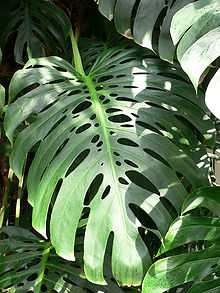Monstera deliciosa
| Monstera deliciosa | |
|---|---|
 | |
| Scientific classification | |
| Kingdom: | Plantae |
| (unranked): | Angiosperms |
| (unranked): | Monocots |
| Order: | Alismatales |
| Family: | Araceae |
| Subfamily: | Monsteroideae |
| Tribe: | Monstereae |
| Genus: | Monstera |
| Species: | M. deliciosa |
| Binomial name | |
| Monstera deliciosa Liebm. | |
Monstera deliciosa is a species of flowering plant native to tropical rainforests of southern Mexico, south to Colombia.[1] It has been introduced to many tropical areas, and has become a mildly invasive species in Hawaii.
Names
The specific epithet deliciosa means "delicious", referring to the edible fruit.
Common names include ceriman, Swiss cheese plant (or just cheese plant), fruit salad plant, monster fruit, monsterio delicio, monstereo, Mexican breadfruit, locust and wild honey, windowleaf, balazo, and Penglai banana.[2]
Description
This member of the arum family Araceae is an epiphyte with aerial roots, able to grow up to 20 m (65 feet) high with large, leathery, glossy, heart-shaped leaves 25–90 cm (9 to 35 inches) long by 25–75 cm broad. Young plants have leaves that are smaller and entire with no lobes or holes, but soon produce lobed and fenestrate leaves.[3]
Wild seedlings grow towards the darkest area they can find until they find a tree trunk, then start to grow up towards the light, creeping up the tree.[4]
Cultivation
The plant is commonly grown for interior decoration in public buildings and as a houseplant. It grows best between the temperatures of 20–30 °C (68–86 °F) and requires high humidity and shade. Growth ceases below 10 °C (50 °F) and it is killed by frost. In the coastal zones of Sicily, especially in the Palermo area, where it is called "zampa di leone" ("lion's paw"), it is often cultivated outdoors. In ideal conditions it flowers about three years after it is planted. Flowering is rare when grown indoors. The plant can be propagated by taking cuttings of a mature plant or by air layering.
This species[5] and the cultivar 'Variegata'[6] have gained the Royal Horticultural Society's Award of Garden Merit.
Fruit
The fruit is up to 25 cm long and 3–4 cm diameter, looking like a green ear of maize covered with hexagonal scales.
Fruits of plants of the Araceae (Arum family) often contain Raphides and Trichosclereids – needle-like structures of calcium oxalate.
The fruit may be ripened by cutting it when the first scales begin to lift up and it begins to exude a pungent odor. It is wrapped in a paper bag and set aside until the scales begin popping off. The scales are then brushed off or fall away to reveal the edible flesh underneath. The flesh, which is similar to pineapple in texture, can be cut away from the core and eaten. It has a fruity taste similar to jackfruit and pineapple. The unripe green fruits can irritate the throat and the latex of the leaves and vines can create rashes in the skin, because both contain potassium oxalate: that is the reason why the fruits have to be consumed when the scales lift up.[7]
Plants grown indoors in temperate regions occasionally produce flowers and fruit.
Other uses
The aerial roots have been used as ropes in Peru, and to make baskets in Mexico.[4]
In Mexico, a leaf or root infusion is drunk daily to relieve arthritis.[4]
In Martinique the root is used to make a remedy for snakebite.[4]
In Colombia it is used as a decorative plant.[8]
-
Monstera fruit
-
Monstera fruit (unripe)
-

Monstera flower
-

Leaf
-

Leaf and flower
-

Growing fruit
References
- ↑ "Monstera deliciosa". Germplasm Resources Information Network. United States Department of Agriculture. 2006-02-22. Retrieved 2009-02-10.
- ↑ Bartholomew, Terese Tse, et al. (eds.). The Charming Cicada Studio: Masterworks by Chao Shao-an. Asian Art Museum of San Francisco, 1997. p40.
- ↑ http://www.hort.purdue.edu/newcrop/morton/ceriman.html Fruits of warm climates pp. 15–17 (1987) access date 2010-07-09
- ↑ 4.0 4.1 4.2 4.3 Online reference to Monstera deliciosa
- ↑ "RHS Plant Selector – Monstera deliciosa". Retrieved 25 May 2013.
- ↑ "RHS Plant Selector – Monstera deliciosa 'Variegata'". Retrieved 25 May 2013.
- ↑ "Plantas silvestres alimenticias fe uso tradicional en las comunidades de Pacurita, San José de Purre y Guayabal". Reuna.unalmed.edu.co. Retrieved 2012-01-30.
- ↑ "Balazo – Monstera deliciosa Liebm – Banco de Objetos de Aprendizaje y de Información" (in (Spanish)). Aprendeenlinea.udea.edu.co. Retrieved 2012-01-30.
External links
| Wikimedia Commons has media related to Monstera deliciosa. |
| Wikispecies has information related to: Tribu Monstereae |

